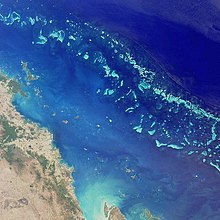
Back Groot Koraalrif Afrikaans Great Barrier Reef ALS ታላቁ ገዳቢ ተሬ Amharic Gran barrera de coral AN الحيد المرجاني العظيم Arabic বৃহৎ প্ৰবাল প্ৰাচীৰ Assamese Gran barrera de coral AST Böyük Sədd rifi Azerbaijani بؤیوک مرجان دیواری AZB Оло Барьерлы риф Bashkir
| UNESCO World Heritage Site | |
|---|---|
 Satellite image of part of the Great Barrier Reef adjacent to the Queensland coastal areas of Airlie Beach and Mackay. | |
| Location | Off the east coast of the Queensland mainland, Australia |
| Criteria | Natural: vii, viii, ix, x |
| Reference | 154 |
| Inscription | 1981 (5th Session) |
| Area | 34,870,000 ha |
| Website | www |
| Coordinates | 18°17′10″S 147°42′00″E / 18.28611°S 147.70000°E |

The Great Barrier Reef is the world's largest coral reef. It is near the coast of Queensland, Australia. It is made up of nearly 2900 coral reefs and over 600 islands.[1] It is 327,800 km2 big and 2600 km long. It has been listed an important World Heritage Site by UNESCO. The Great Barrier Reef is the biggest structure made by living things. It can be seen from outer space.[2] The Reefs are threatened.[3] The biggest threat to the Great Barrier Reef today is coral bleaching caused by high sea water temperatures as a result of global warming.[4] During 2016, the worst die-off ever recorded occurred, due to seas warming around the Great Barrier Reef. Two-thirds of a 700-km (435 miles) stretch of coral in nine months were killed.[5]
- ↑ Cite error: The named reference
CRCagewas used but no text was provided for refs named (see the help page). - ↑ Bellfield, Sarah (February 8, 2002). "Great Barrier Reef: no buried treasure". Geoscience Australia. Archived from the original on October 1, 2007. Retrieved December 1, 2008.
- ↑ Explorer Pleads to Save the Great Barrier Reef May 1, 2014 issue Scientific American
- ↑ "CNN: Warm seas threaten Great Barrier Reef". CNN.
- ↑ Tom Westbrook. "Biggest-Ever Coral Die-Off Reported on Australia's Great Barrier Reef; Warm seas have "essentially cooked" hundreds of kilometers of the landmark, a surveyor says". Scientific American. Retrieved 7 December 2016.
© MMXXIII Rich X Search. We shall prevail. All rights reserved. Rich X Search

